Estimating Urban Evapotranspiration at 10m Resolution Using Vegetation Information from Sentinel-2: A Case Study for the Beijing Sponge City
Abstract
1. Introduction
2. Materials and Methods
2.1. Observational Forcing Datasets
2.1.1. Land Cover Map at 10m Resolution Derived from Sentinel-2
2.1.2. NDVI and LAI at 10m Resolution Derived from Sentinel-2
2.1.3. Surface Climate Driving Dataset
2.2. PML-V2.1 Model
2.2.1. Energy Balance at Urban Land Surface
2.2.2. Canopy Transpiration ( ) and Soil Evaporation ()
2.2.3. Interception Evaporation () by Canopy Vegetation
2.2.4. Impervious Surface Evaporation ()
2.2.5. Open-Water Evaporation ()
3. Results
3.1. Validation of Estimated LAI and ET
3.2. Land Use and Vegetation Information in Beijing Sponge City
3.3. ET and Related Variables in Beijing Sponge City
4. Discussion
5. Conclusions
Author Contributions
Funding
Data Availability Statement
Acknowledgments
Conflicts of Interest
References
- Teuling, A.J.; de Badts, E.A.G.; Jansen, F.A.; Fuchs, R.; Buitink, J.; Hoek van Dijke, A.J.; Sterling, S.M. Climate change, reforestation/afforestation, and urbanization impacts on evapotranspiration and streamflow in Europe. Hydrol. Earth Syst. Sci. 2019, 23, 3631–3652. [Google Scholar] [CrossRef]
- Gong, P.; Liang, S.; Carlton, E.J.; Jiang, Q.; Wu, J.; Wang, L.; Remais, J.V. Urbanisation and health in China. Lancet 2012, 379, 843–852. [Google Scholar] [CrossRef]
- Wang, X.; Liu, H.; Miao, S.; Wu, Q.; Zhang, N.; Qiao, F. Effectiveness of Urban Hydrological Processes in Mitigating Urban Heat Island and Human Thermal Stress during a Heat Wave Event in Nanjing, China. J. Geophys. Res. Atmos. 2020, 125. [Google Scholar] [CrossRef]
- Ramamurthy, P.; Bou-Zeid, E. Contribution of impervious surfaces to urban evaporation. Water Resour. Res. 2014, 50, 2889–2902. [Google Scholar] [CrossRef]
- Wang, L.; Huang, M.; Li, D. Where Are White Roofs More Effective in Cooling the Surface? Geophys. Res. Lett. 2020, 47. [Google Scholar] [CrossRef]
- Zhang, Y.; Xia, J.; Yu, J.; Randall, M.; Zhang, Y.; Zhao, T.; Pan, X.; Zhai, X.; Shao, Q. Simulation and assessment of urbanization impacts on runoff metrics: Insights from landuse changes. J. Hydrol. 2018, 560, 247–258. [Google Scholar] [CrossRef]
- Gong, P.; Liu, H.; Zhang, M.; Li, C.; Wang, J.; Huang, H.; Clinton, N.; Ji, L.; Li, W.; Bai, Y.; et al. Stable classification with limited sample: Transferring a 30-m resolution sample set collected in 2015 to mapping 10-m resolution global land cover in 2017. Sci. Bull. 2019, 64, 370–373. [Google Scholar] [CrossRef]
- Sentinel-2. Overview of Sentinel-2 Mission. 2015. Available online: https://sentinel.esa.int/web/sentinel/missions/sentinel-2 (accessed on 8 April 2021).
- The People’s Government of Beijing Municipality. Announcement of Beijing Sponge City Project. 2017. Available online: http://www.beijing.gov.cn/zhengce/zhengcefagui/201905/t20190522_60725.html (accessed on 8 April 2021).
- He, J.; Yang, K.; Tang, W.; Lu, H.; Qin, J.; Chen, Y.; Li, X. The first high-resolution meteorological forcing dataset for land process studies over China. Sci. Data 2020, 7, 25. [Google Scholar] [CrossRef]
- Farquhar, G.D.; von Caemmerer, S.; Berry, J.A. A biochemical model of photosynthetic CO2 assimilation in leaves of C 3 species. Planta 1980, 149, 78–90. [Google Scholar] [CrossRef]
- Yu, Q.; Zhang, Y.; Liu, Y.; Shi, P. Simulation of the stomatal conductance of winter wheat in response to light, temperature and CO2 changes. Ann. Bot. 2004, 93, 435–441. [Google Scholar] [CrossRef]
- Monteith, J.L. Evaporation and environment. The state and movement of water in living organisms. In Symposium of the Society of Experimental Biology; Fogg, G.E., Ed.; Cambridge University Press: Cambridge, UK, 1965; Volume 19, pp. 205–234. [Google Scholar]
- Leuning, R.; Zhang, Y.Q.; Rajaud, A.; Cleugh, H.; Tu, K. A simple surface conductance model to estimate regional evaporation using MODIS leaf area index and the Penman-Monteith equation. Water Resour. Res. 2008, 44. [Google Scholar] [CrossRef]
- Zhang, Y.; Leuning, R.; Hutley, L.B.; Beringer, J.; McHugh, I.; Walker, J.P. Using long-term water balances to parameterize surface conductances and calculate evaporation at 0.05° spatial resolution. Water Resour. Res. 2010, 46. [Google Scholar] [CrossRef]
- Zhang, Y.; Kong, D.; Gan, R.; Chiew, F.H.S.; McVicar, T.R.; Zhang, Q.; Yang, Y. Coupled estimation of 500 m and 8-day resolution global evapotranspiration and gross primary production in 2002–2017. Remote Sens. Environ. 2019, 222, 165–182. [Google Scholar] [CrossRef]
- Zhang, Y.; Pena-Arancibia, J.L.; McVicar, T.R.; Chiew, F.H.; Vaze, J.; Liu, C.; Lu, X.; Zheng, H.; Wang, Y.; Liu, Y.Y.; et al. Multi-decadal trends in global terrestrial evapotranspiration and its components. Sci. Rep. 2016, 6, 19124. [Google Scholar] [CrossRef] [PubMed]
- Gan, R.; Zhang, Y.; Shi, H.; Yang, Y.; Eamus, D.; Cheng, L.; Chiew, F.H.S.; Yu, Q. Use of satellite leaf area index estimating evapotranspiration and gross assimilation for Australian ecosystems. Ecohydrology 2018, 11. [Google Scholar] [CrossRef]
- van Dijk, A.I.J.M.; Bruijnzeel, L.A. Modelling rainfall interception by vegetation of variable density using an adapted analytical model. Part 1. Model description. J. Hydrol. 2001, 247, 230–238. [Google Scholar] [CrossRef]
- van Dijk, A.I.J.M.; Bruijnzeel, L.A. Modelling rainfall interception by vegetation of variable density using an adapted analytical model. Part 2. Model validation for a tropical upland mixed cropping system. J. Hydrol. 2001, 247, 239–262. [Google Scholar] [CrossRef]
- Gash, J.H.C. An analytical model of rainfall interception by forests. Q. J. R. Meteorol. Soc. 1979, 105, 43–55. [Google Scholar] [CrossRef]
- Gash, J.H.C.; Lloyd, C.R.; Lachaud, G. Estimating sparse forest rainfall interception with an analytical model. J. Hydrol. 1995, 170, 79–86. [Google Scholar] [CrossRef]
- Hong, J.; Wang, S. Estimation and distribution characteristics of evaporation from water surfaces in Beijing, Tianjin and Tangshan areas. Geogr. Res. 1987, 6, 68–75. (In Chinese) [Google Scholar]
- Hanna, S.; Marciotto, E.; Britter, R. Urban Energy Fluxes in Built-Up Downtown Areas and Variations across the Urban Area, for Use in Dispersion Models. J. Appl. Meteorol. Climatol. 2011, 50, 1341–1353. [Google Scholar] [CrossRef]
- Zhou, J.; Liu, J.; Yan, D.; Wang, H.; Wang, Z.; Shao, W.; Luan, Y. Dissipation of water in urban area, mechanism and modelling with the consideration of anthropogenic impacts: A case study in Xiamen. J. Hydrol. 2019, 570, 356–365. [Google Scholar] [CrossRef]
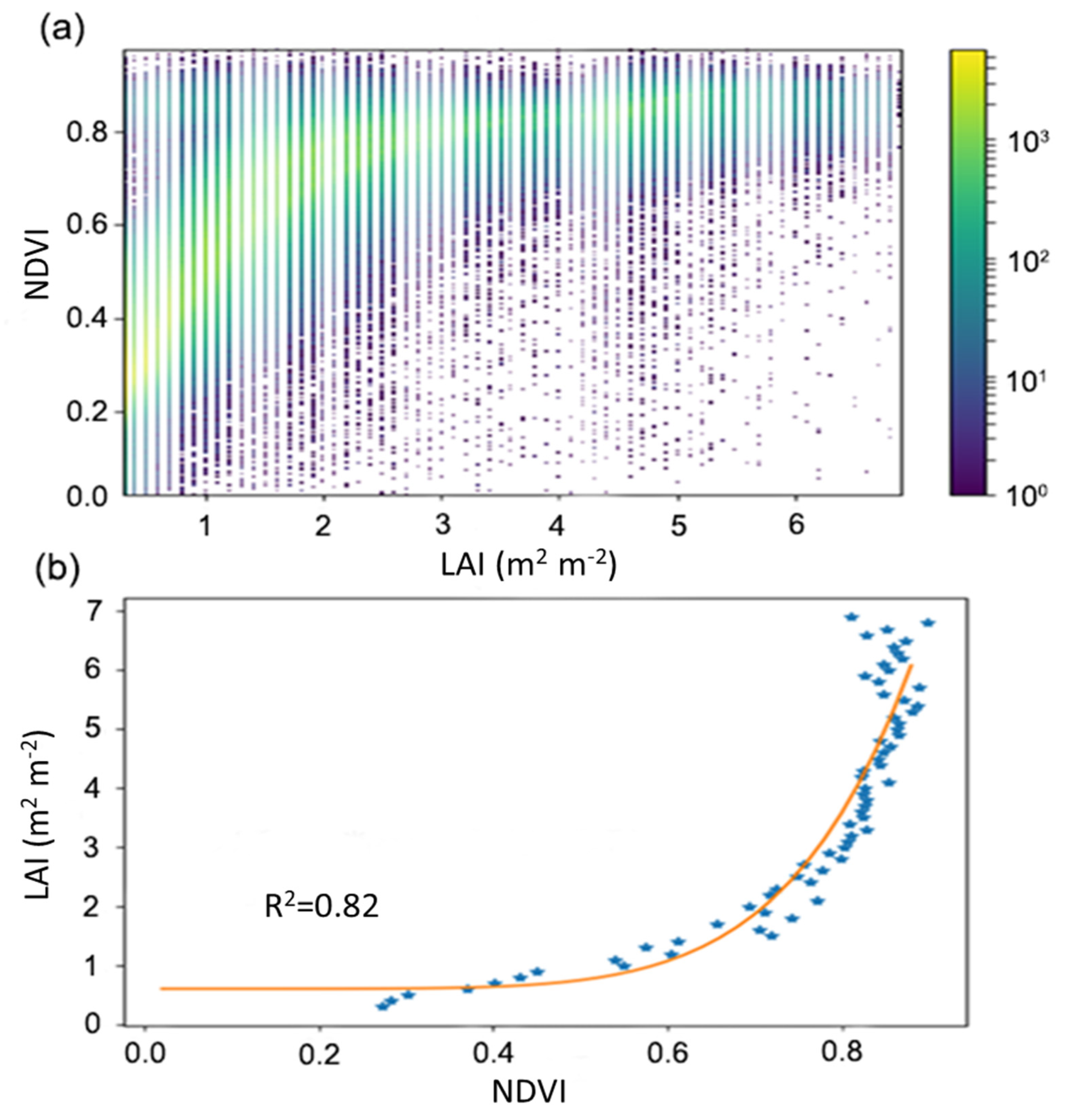
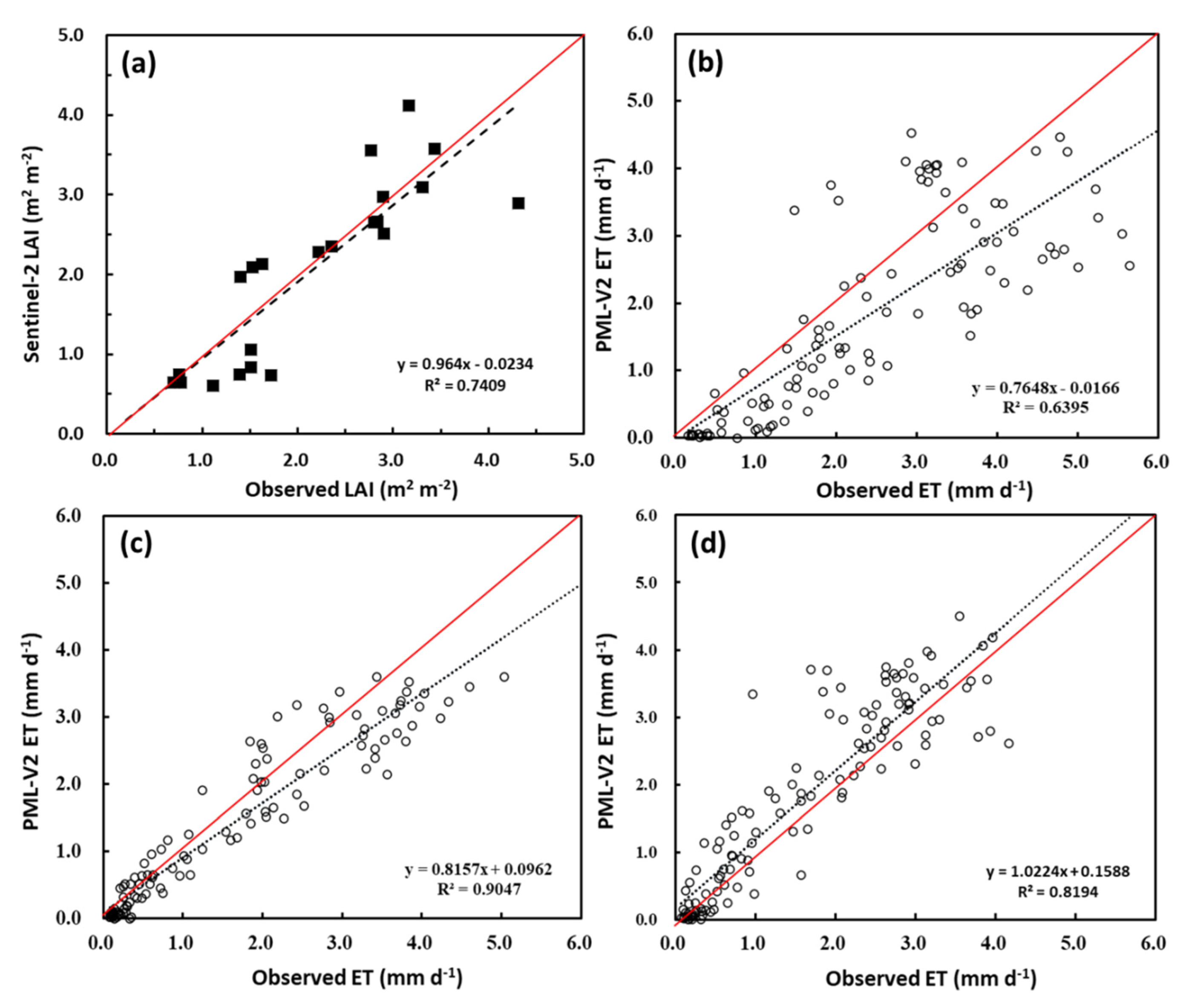
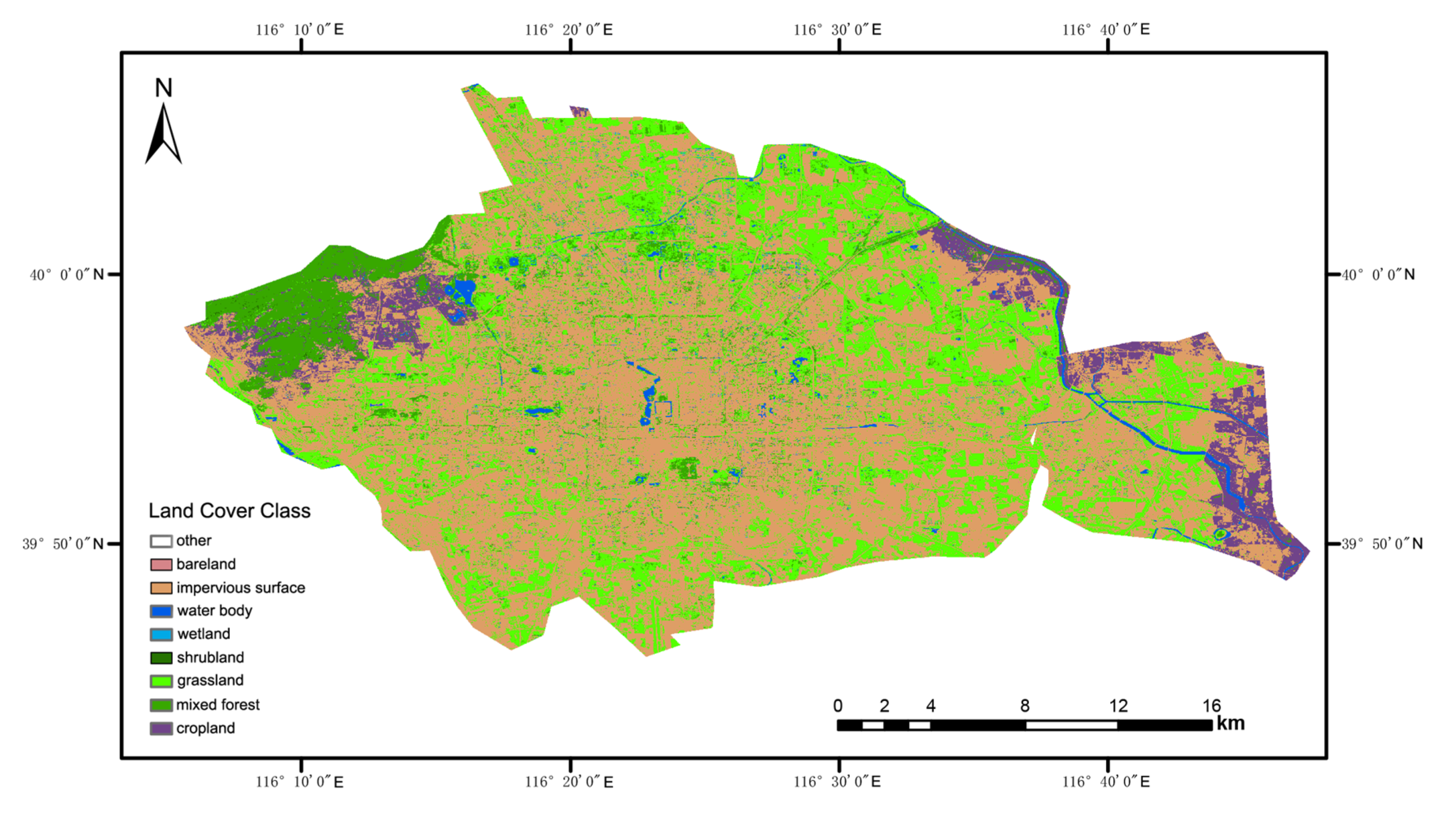

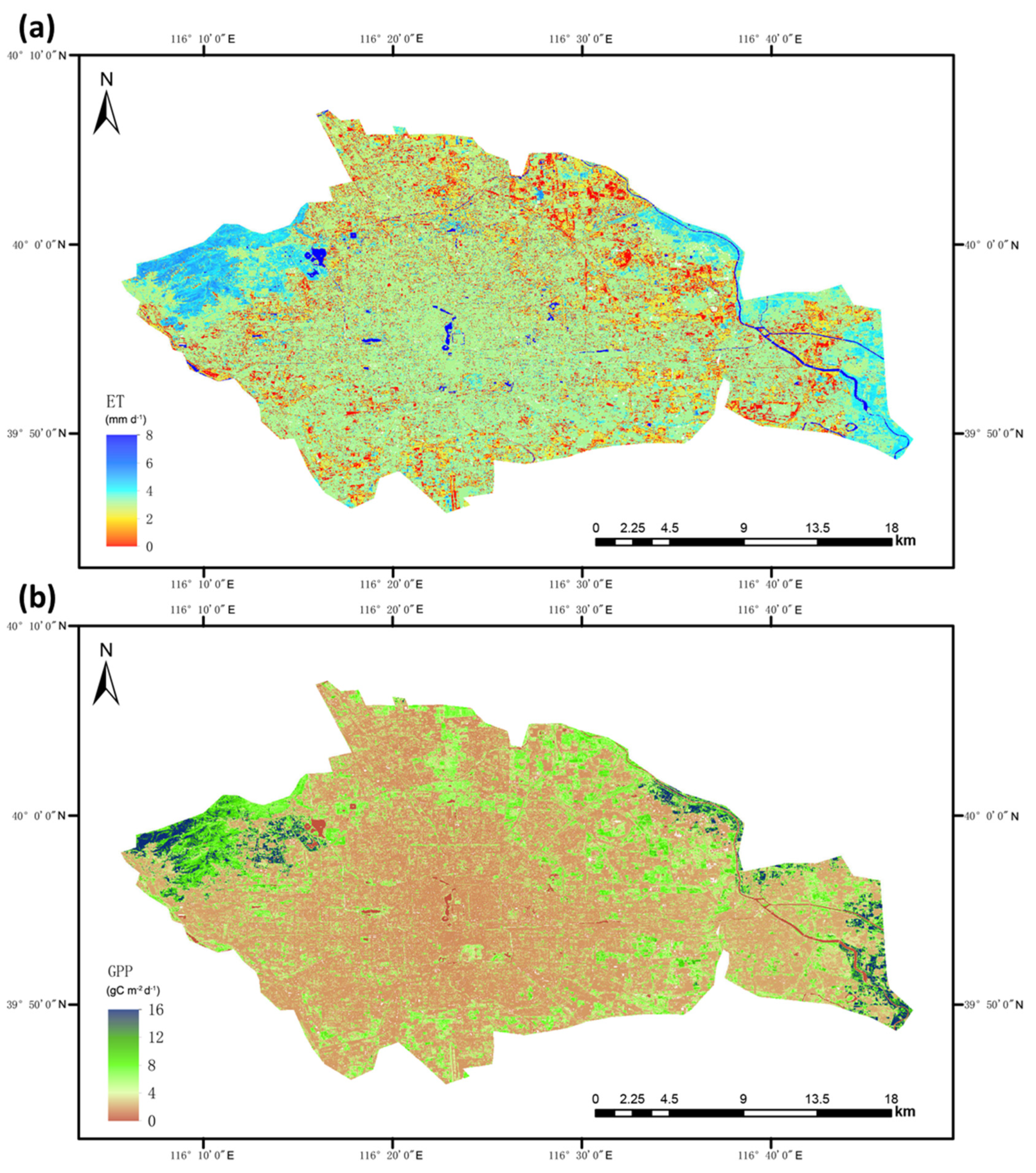
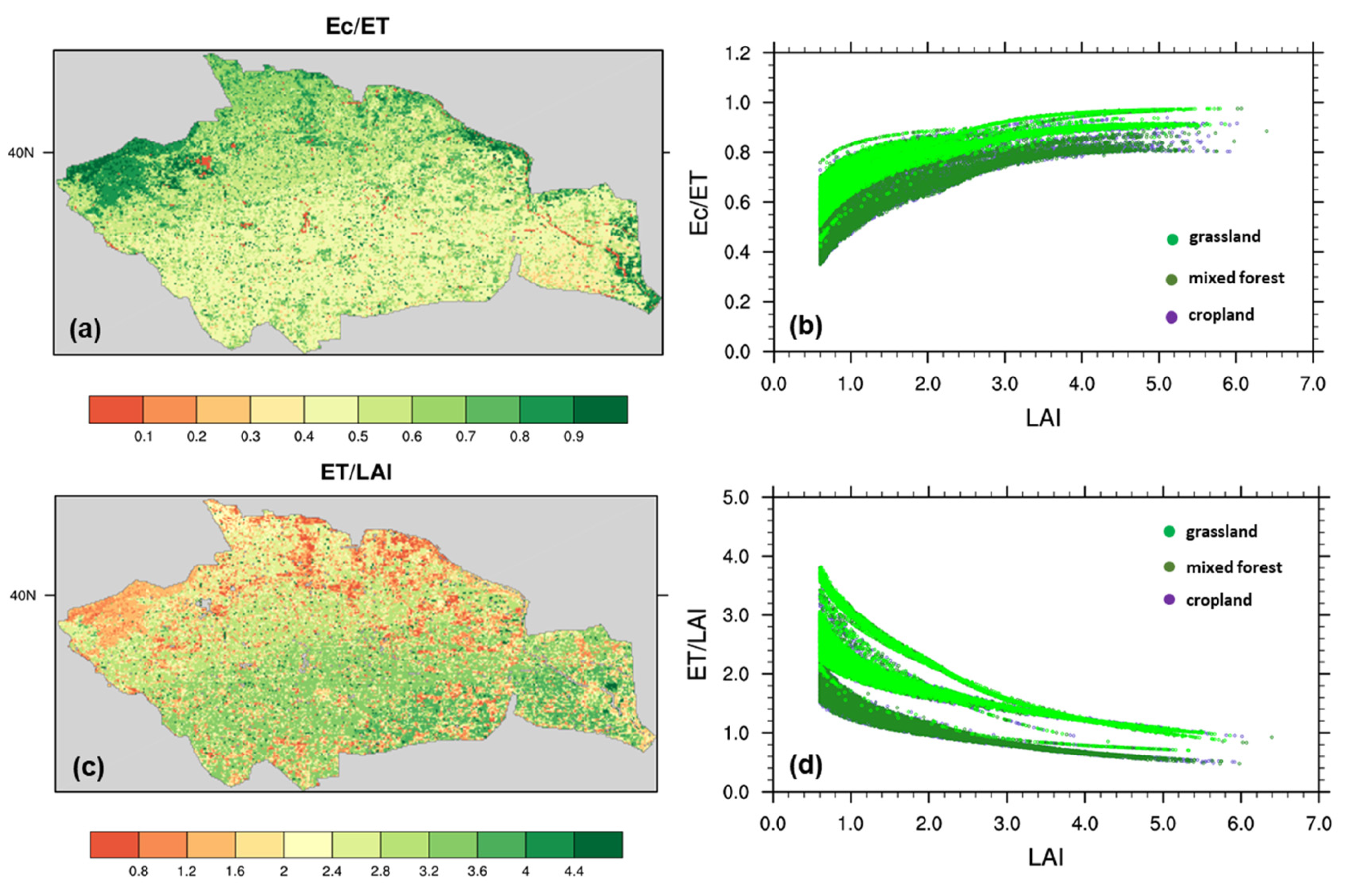
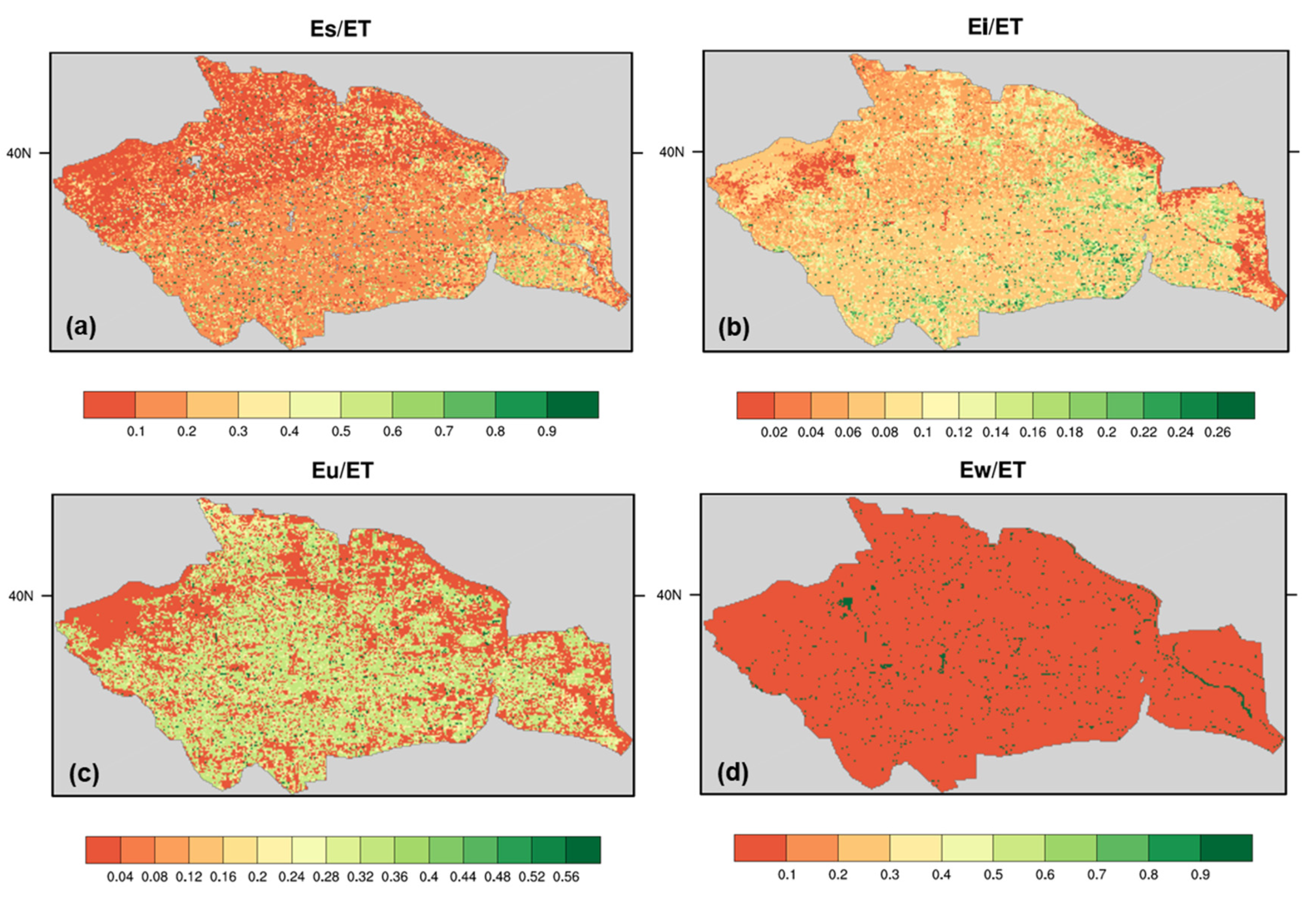
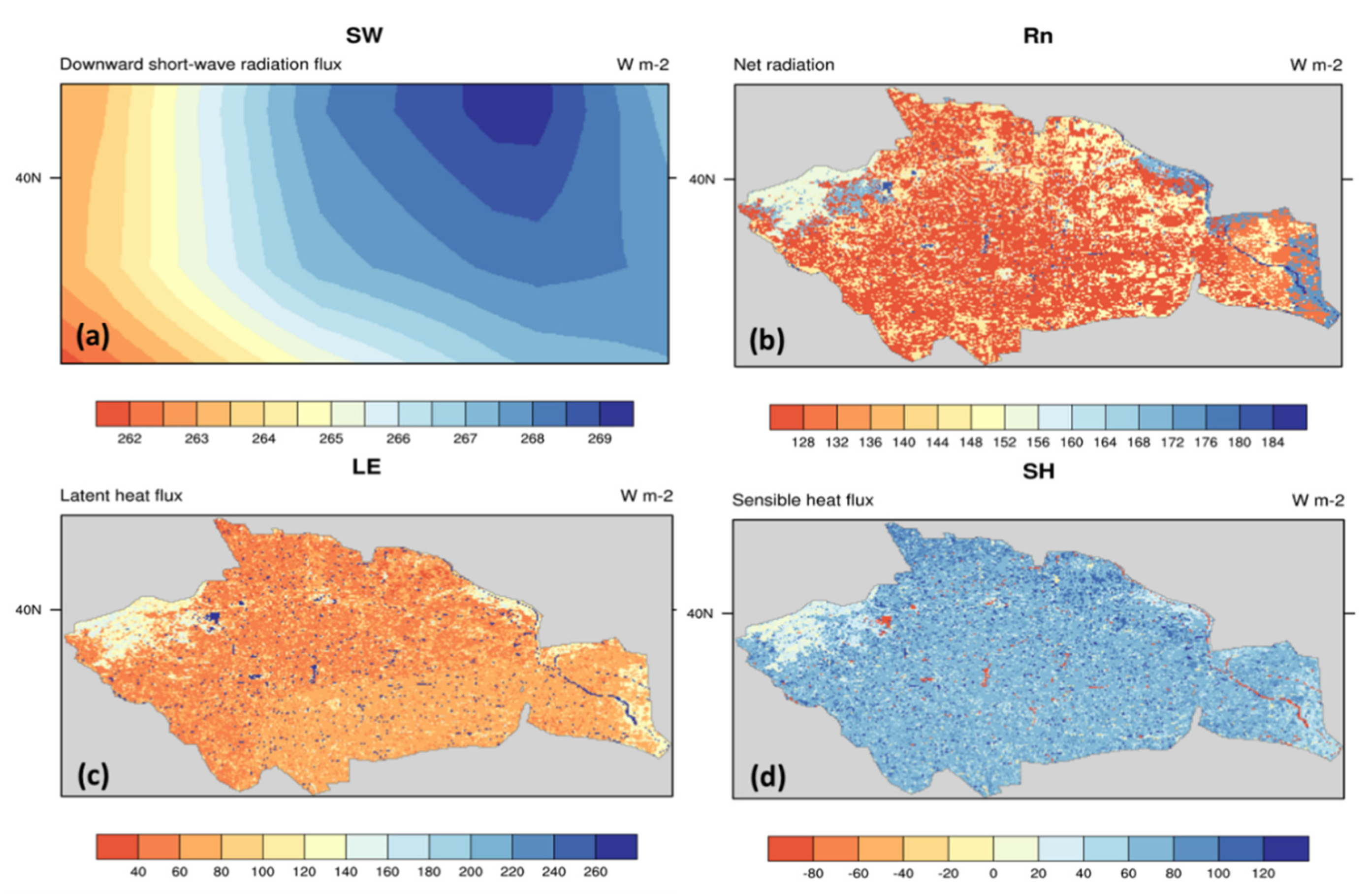
| Parameter | Definition | Unit | Land Cover Classification (a) | |||||||
|---|---|---|---|---|---|---|---|---|---|---|
| CRO | MIF | GRA | SHR | WET | WAT | IMP | BAR | |||
| Surface albedo for shortwave radiation | − | 0.150 | 0.150 | 0.250 | 0.250 | 0.250 | 0.050 | 0.350 | 0.350 | |
| Emissivity for longwave radiation | − | 0.960 | 0.990 | 0.950 | 0.950 | 0.960 | 0.990 | 0.940 | 0.940 | |
| Reference vapor pressure deficit at stomatal conductance reduction | kPa | 2.000 | 0.552 | 0.638 | 0.864 | 0.661 | 0.700 | 0.552 | 0.864 | |
| Extinction coefficient of PAR | − | 0.721 | 0.386 | 0.595 | 0.230 | 0.996 | 0.600 | 0.386 | 0.230 | |
| Extinction coefficient of available energy | − | 0.899 | 0.899 | 0.900 | 0.888 | 0.888 | 0.700 | 0.899 | 0.888 | |
| Specific canopy rainfall storage capacity per unit leaf area | mm | 0.010 | 0.198 | 0.227 | 0.014 | 0.022 | 0.000 | 0.198 | 0.014 | |
| Specific ratio of evaporation rate over rainfall intensity per unit vegetation cover | − | 0.092 | 0.256 | 0.010 | 0.010 | 0.017 | 0.000 | 0.256 | 0.010 | |
| Specific canopy rainfall storage capacity per unit impervious surface area | mm | 0.014 | 0.014 | 0.014 | 0.014 | 0.014 | 0.014 | 0.014 | 0.014 | |
| Reference LAI | m | 5.000 | 5.000 | 5.000 | 5.000 | 5.000 | 5.000 | 5.000 | 5.000 | |
| h | Canopy height | m | 1.000 | 10.00 | 0.5000 | 10.000 | 0.500 | 0.500 | 10.00 | 0.500 |
| Maximum catalytic capacity of Rubisco per unit leaf area at 25℃ | μmol m−2 s−1 | 22.560 | 28.450 | 29.560 | 18.770 | 24.440 | 0.000 | 28.450 | 18.770 | |
| Initial photochemical efficiency | − | 0.029 | 0.029 | 0.029 | 0.029 | 0.029 | 0.000 | 0.029 | 0.029 | |
| Initial value of the slope of CO2 response curve | mol m−2 s−1 | 0.069 | 0.040 | 0.026 | 0.024 | 0.069 | 0.000 | 0.040 | 0.024 | |
| Ball-Berry coefficient | − | 5.289 | 8.355 | 3.934 | 4.406 | 9.211 | 0.000 | 8.355 | 4.406 | |
| The threshold below which there is no vapor pressure constraint | kPa | 1.499 | 0.711 | 0.650 | 1.493 | 0.664 | 1.000 | 0.711 | 1.493 | |
| The threshold above which there is no assimilation | kPa | 6.500 | 3.500 | 5.199 | 5.797 | 5.188 | 6.500 | 3.500 | 5.797 | |
| District in Beijing Sponge City | LAI (m2 m−2) | ET (mm d−1) | GPP (gC m−2 d−1) |
|---|---|---|---|
| Xicheng | 0.66 | 1.62 | 2.36 |
| Dongcheng | 0.70 | 1.60 | 2.44 |
| Shijingshan | 1.05 | 1.67 | 3.53 |
| Haidian | 0.93 | 1.64 | 3.10 |
| Chaoyang | 0.84 | 1.51 | 2.79 |
| Fengtai | 0.74 | 1.50 | 2.56 |
| Tongzhou | 0.86 | 1.66 | 3.01 |
| Overall Mean | 0.83 | 1.60 | 2.83 |
Publisher’s Note: MDPI stays neutral with regard to jurisdictional claims in published maps and institutional affiliations. |
© 2021 by the authors. Licensee MDPI, Basel, Switzerland. This article is an open access article distributed under the terms and conditions of the Creative Commons Attribution (CC BY) license (https://creativecommons.org/licenses/by/4.0/).
Share and Cite
Zhang, X.; Song, P. Estimating Urban Evapotranspiration at 10m Resolution Using Vegetation Information from Sentinel-2: A Case Study for the Beijing Sponge City. Remote Sens. 2021, 13, 2048. https://doi.org/10.3390/rs13112048
Zhang X, Song P. Estimating Urban Evapotranspiration at 10m Resolution Using Vegetation Information from Sentinel-2: A Case Study for the Beijing Sponge City. Remote Sensing. 2021; 13(11):2048. https://doi.org/10.3390/rs13112048
Chicago/Turabian StyleZhang, Xuanze, and Peilin Song. 2021. "Estimating Urban Evapotranspiration at 10m Resolution Using Vegetation Information from Sentinel-2: A Case Study for the Beijing Sponge City" Remote Sensing 13, no. 11: 2048. https://doi.org/10.3390/rs13112048
APA StyleZhang, X., & Song, P. (2021). Estimating Urban Evapotranspiration at 10m Resolution Using Vegetation Information from Sentinel-2: A Case Study for the Beijing Sponge City. Remote Sensing, 13(11), 2048. https://doi.org/10.3390/rs13112048







